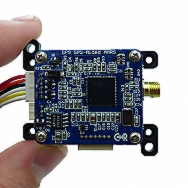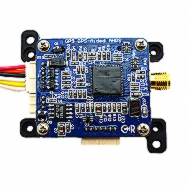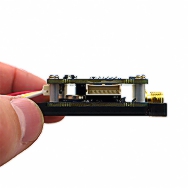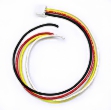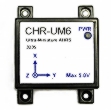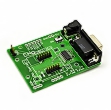GP9: GPS-Aided AHRS
The GP9 has been discontinued and is no longer available for purchase. The GP9 is a GPS-aided AHRS that measures orientation, velocity, and position at 500 Hz. The GP9 combines temperature-compensated rate gyros, accelerometers, magnetometers, and absolute air pressure with GPS to produce angle estimates that are reliable even during aggressive dynamic maneuvers. Unlike more simple attitude sensors, the GP9 is capable of measuring its yaw angle without relying on unpredictable magnetic field measurements.
Price each:
$0.00
Overview
The GP9 is a GPS-Aided Attitude and Heading Reference System (GPS-Aided AHRS). Its primary function is to provide a robust attitude solution on dynamic platforms. The GP9 uses its attitude estimate in conjunction with the onboard accelerometers to measure changes in velocity. These velocity estimates are then compared to velocities reported by the GPS and pressure sensors. Since attitude inaccuracy is a major source of velocity measurement error, it is possible to measure attitude by comparing the accelerometer-based velocity with GPS-based velocity. Because attitude correction takes place as the result of changes in velocity, the GP9 actually performs better during aggressive acceleration and deceleration. Other comparably-priced sensors on the market produce estimates that can become arbitrarily poor on moving platforms.
In order to produce the best possible accuracy, the GP9 doesn’t just estimate angles - it also estimates biases that can cause angle estimates to drift. The onboard bias estimators ensure that the GP9’s angle outputs remain reliable for as long as possible even when the sensor is not moving.
Calibration Options
The rate gyros and accelerometers on the GP9 are calibrated for scale factor, bias, and cross-axis alignment errors. Customers can choose to have calibration performed at a single temperature (~ 25 C) or, for better performance, the Extended calibration option can be selected (calibration good from 0 C to 50 C).
Note: For units with the extended calibration range, shipments typically leave up to two business days from the order date. Units with single-point calibration typically ship next business day.
The GP9 comes mounted on CNC-machined mounting brackets. The brackets, with holes for precision alignment dowel pins, can be used to help mount the GP9 in its exact calibration orientation. Alternatively, users can save some space and reduce weight be removing the brackets and mounting the GP9 directly to a host assembly.
The GP9 ships with an active GPS antenna with magnetic mount base.
High performance
- Produces attitude and heading estimates that perform well during aggressive dynamic motion
- Measures yaw/heading without relying on magnetic sensors
- Excellent gyro bias stability over temperature
- Adjustable low-pass filter and EKF settings provide customizable performance for various applications.
- States and sensor data synchronized to GPS position and velocity using optional external GPS module.
- Calibrated to correct for cross-axis misalignment, scale factor, and bias errors on accelerometers and rate gyros.
- Magnetometer soft and hard-iron calibration
Lower Cost
- State-of-the-art MEMS devices designed for mass-market consumer applications drastically lowers cost
- OEM version reduces overall cost, size, and weight
Ease of use
- Transmits data using binary packets for higher efficiency
- Flexible communication architecture allows the GP9 to transmit any combination of data at individually adjustable rates
- Connects to the CHR Serial Interface software to allow for real-time plotting of sensor data, logging, device configuration, and magnetometer calibration
Specifications*
- 500 Hz Update Rate
- +/- 2 degree static pitch/roll accuracy
- +/- 1 degree dynamic pitch/roll accuracy
- +/- 5 degree static yaw accuracy (using magnetometer)
- +/- 1 degree dynamic yaw accuracy (with good GPS lock)
- +/- 2000 deg/s gyro range
- +/- 8 g accelerometer range
- Resolution < 0.01 degrees
- Data output rate: 0 to 255 Hz, selectable data
- Output data: acceleration, angular rates, magnetic field, barometric pressure, GPS altitude, position, velocity, attitude (quaternion, Euler Angle).
GPS Specifications
- Typical Position Accuracy: 2.5m CEP
- Typical Velocity Accuracy: 0.1 m/s
- Timing Accuracy: 60ns
- Max GPS Dynamics: 4G
- Operational Limits, Altitude: 18,000 m, Velocity: 515 m/s
- Open Sky TTFF: 29 second cold start, 1 second hot start (battery backup included)
Gyro Specifications
- Sensitivity change vs. temperature: +/- 2%
- Rate noise density: 0.03 deg/s/rtHz
- Non-linearity: 0.2% FS
Other
- Vin: 5.0V nominal
- Communication: 3.3V TTL UART
- Baud Rates Supported: 9600, 14400, 19200, 38400, 57600, 115200, 128000, 153600, 230400, 256000, 460800, 921600
- Power consumption: < 150mA at 5.0V during GPS seek. < 100mA at 5.0V with GPS lock
- Operating Temperature: -40C to +85C
- Dimensions: 1.5″ x 1.3″ x 0.5″
- Weight: 0.4 oz (11 grams)
* Performance specifications assume that the sensor is calibrated. Dynamic specs assume reliable GPS lock. Performance can degrade at uncalibrated temperature ranges and with loss of GPS lock, or in the presence of significant GPS multipath error.
Documentation
Downloads
- CHR Serial Interface
Use the Serial Interface software to configure the GP9, log data, and plot data in real-time.
- Shop
- / Inertial and Orientation Sensors
- / GP9: GPS-Aided AHRS
- Views:
-
UM6 4-pin Cable Assembly
Extra 4-pin data cable for interfacing with the UM6 through its side connector
-
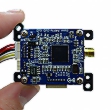
GP9: GPS-Aided AHRS
The GP9 has been discontinued and is no longer available for purchase. The GP9 is a GPS-aided AHRS that measures orientation, velocity, and position at 500 Hz. The GP9 combines temperature-compensated rate gyros, accelerometers, magnetometers, and absolute air pressure with GPS to produce angle estimates that are reliable even during aggressive dynamic maneuvers. Unlike more simple attitude sensors, the GP9 is capable of measuring its yaw angle without relying on unpredictable magnetic field measurements.
-

Hydra: Smart DC Power Supply
DISCONTINUED. The Hydra has been discontinued and is no longer available for purchase.
-
UM6 Orientation Sensor
Discontinued. Upgrade to the new UM7.
-
UM6 Serial Expansion Board
Discontinued. Expansion board, serial cable, and power supply for connecting the UM6 to your PC through a serial port.
-
